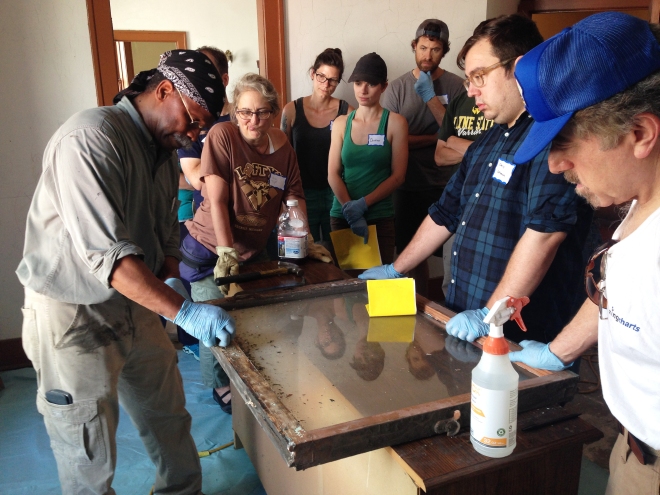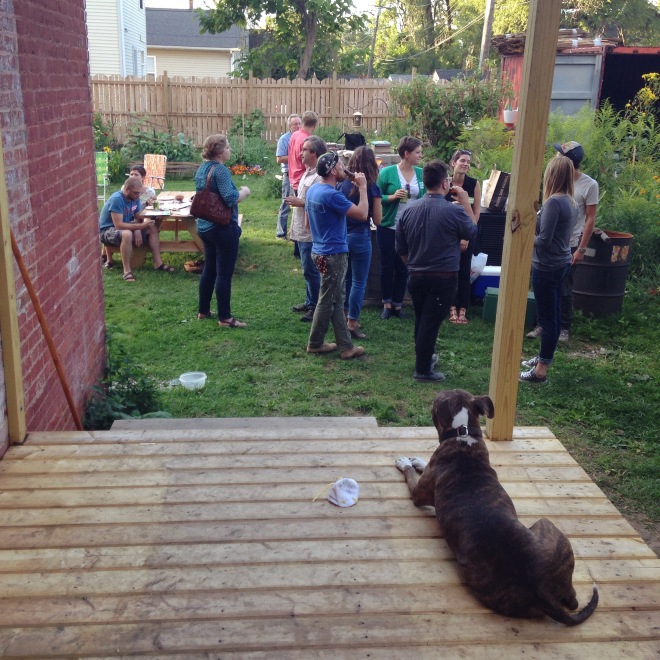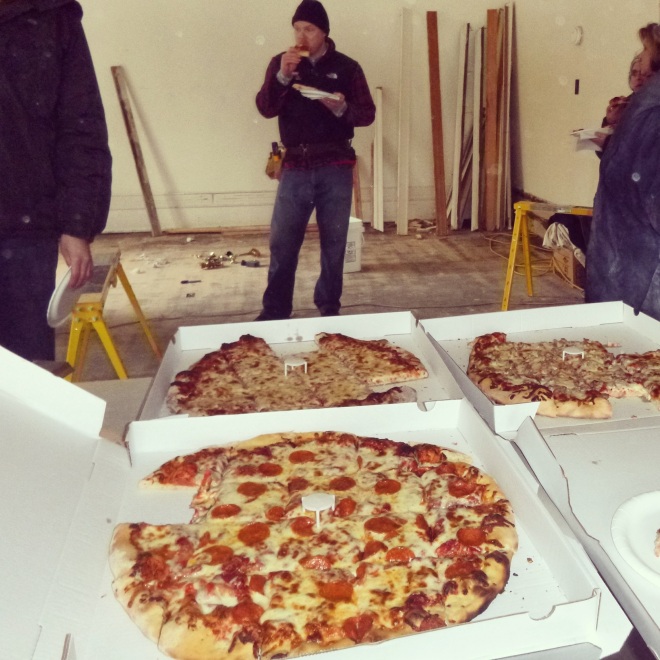
Brick + Beam Detroit is a collaboration between the Michigan Historic Preservation Network, Detroit Future City, and Preservation Detroit. Victoria Byrd Olivier, and Amy Elliott Bragg, and Emilie Evans are the founders (L-R). Yes, all women, which makes this writer giddy.
So, I’ve noticed a bit of a theme recently. The ToolMade Project (TMP) has partnered with numerous organizations and amazing humans working their tails off in Rust Belt cities, though perhaps that’s not much of a surprise. Both the need and the efforts in this region have been so great. But, the work taking place in these cities is not merely triage. Economists, urban planners, architectural historians and other nerds obsessed with the built environment are hailing these cities as hotbeds of innovation as younger generations—those not old enough to have experienced the elevator drop of decline—see only endless potential in the sturdy industrial bones of these cities. All of the stories TMP has covered center on grassroots efforts with local buy-in and hardworking community members, and these efforts have manifested in different ways. Here are just a few of the strategies from recent blog posts that are shaking the iron oxide off the gears of progress:
- Buffalo’s University Heights Tool Library: There’s a definite need to buck the overspecialization of trades and to make tools and resources more affordable and accessible to communities with few resources.
- Detroit’s Americorps Urban Safety Program: Vacant structures need to be secured, lawns need to be mowed, art needs to fill boarded-up windows, and streets need to be cleaned up to make areas safe and to foster optimism in struggling neighborhoods. There may not be money from the city or state, but there are people willing to give their time and energy.
- South Bend’s Historic Preservation Commission: Having a vintage home and some tools is an incredible opportunity, but most people weren’t born knowing how to rehab a structure and require some know-how. Free or inexpensive hands-on workshops are invaluable and empower individuals and the community as a whole.
This month, the TMP has partnered with yet another organization in that region—a group from Detroit—that is creating the bedrock for massive change by fusing many of these strategies. But before you get to hear about the groundbreaking work they’re doing, I thought it might be useful to give a quick and dirty history lesson about what the Rust Belt is exactly, and how these cities—cities with rich histories, ideal geography, and extraordinary infrastructure—experienced such a rapid and devastating decline. So sit back and soak in a little context.

I love me a useful map. Credit: BJennings, 2010
The Rust Belt refers to a region of the U.S. formerly known for its industrial jobs, specifically, steel and automobile manufacturing. It also wouldn’t be a stretch to credit this region with having played a crucial role in winning the second World War, with Pittsburgh alone having produced one-fifth of the Allied forces steel from 1940 to 1945. While boundaries vary depending on the source, in general, the belt stretches across parts of Illinois, Indiana, Michigan, Ohio, Pennsylvania, New York, West Virginia and Wisconsin—areas that thrived because of their readily available coal, labor, and inland waterways. This “industrial heartland of America” was booming until the 1970s, when a number of critical things changed. And they pretty much changed all at once. The steel factories that were the bread and butter for a huge percentage of people were shutting down due to a combination of increased automation, the transfer of manufacturing to the West, several devastating free trade agreements, and the general decline of the steel and coal industries.
As you’d imagine, this created an industrial and economic free fall that changed the realities of hundreds of thousands of people. Specifically, the U.S. worldwide market share of manufactured steel went from 20 percent in 1970 to 12 percent by 1990, and employment in the industry dropped from 400,000 to 140,000 over the same period. The term “Rust Belt” was coined in the 1980s and became synonymous with economic decline, population loss, and urban decay.

Many old homes in Buffalo, NY are vacant and slated for demolition. Fortunately, the city’s Urban Homestead program allows residents to buy these homes for just $1 each, as long as they agree to renovate and occupy them. Programs like these are crucial, but they need additional support from groups who will help homeowners navigate the work.
Needless to say, these cities are still struggling. Populations plummeted when many were forced to move elsewhere for work, and those who remain and are doing what they can do deal with the economic realities and vacant property issues. So it’s a darned good thing that so many organizations are stepping up, like Brick + Beam Detroit.
As I mentioned earlier, Brick + Beam is taking what many pioneering organizations are doing and going a step further. They’re not only educating residents about rehab directly, they’re thinking bigger and creating an infrastructure for a massive community forum with potentially endless resources available to rehabbers. 24/7. This makes a whole lot of sense because, well, maybe you really want to fix your wood windows before winter but oops(!) you missed the one class a year that is offered. What do you do next? Can you do the work yourself, or is there a reasonably priced contractor out there who will actually do the work well? Also, what in god’s name is a glazier point? They’re making resources (and moral support) free and accessible to all.

Workshop instructor Jim Turner demonstrates a paint-scraping technique at a hands-on window restoration workshop. Photo credit: Brick + Beam Detroit
Brick + Beam began by holding monthly (mostly free) events for people wanting to know how to fix up their homes. But these aren’t typical lecture-style meetings. These events include incredibly well attended open mic storytellings (rehab stories!), panel discussions with local contractors to field their questions, and even a “fixer-upper supper club” that was held at the site of an active rehab project. As a result of these events and partnerships with skilled professionals, a community web is beginning to catalyze and rehabbers are sharing their tips (and, likely, minor catastrophes) with others in the same boat.

Brick + Beam put together a “Fixer Upper Supper Club” as a show, tell, and eat event. More useful and more tasty and the old “trick them into attending a meeting with cheap pizza” approach. It’s also a great way to foster community. Photo credit: Brick + Beam Detroit
But beyond these events, they’re also creating a website that will serve as a hub for people interested in property rehab. This will be accessible at all hours as a result, and contain a Q&A forum, a resource library, and a map that shows where the forum members’ properties are located and what they’re working on. These concentrated areas will be “hot spots” that will reveal which neighborhoods are seeing new, concentrated investment–information that can be used in a number of ways. They’re also working on a “Launch Box” that will be stocked with how-to guides, stories, resources, and other goodies for first time homeowners.
The “Launch Box” was something that especially made my ears perk up. It seemed a perfect opportunity for a partnership, so TMP partnered with Craftsman this month to give a handful of homeowners some essential tools they’ll need to fix up their “new” vintage homes, as well as a cheat sheet of tool essentials. These kits were hand delivered last week and we can’t wait to hear (and see) the follow-up!

The Brick + Beam launch party in 2015 brought people together to share their home rehab stories. As you’d imagine, many of these stories are filled with successes and mishaps, and create a wonderful sense of “thank god we’re not the only ones!” Photo credit: Gertrud Høgh Rasmussen
Some Rust Belt Sources and Resources:
- beltmag.com
- https://www.clevelandfed.org/newsroom-and-events/publications/economic-commentary/2013-economic-commentaries/ec-201306-urban-decline-in-rust-belt-cities.aspx
- http://www.newgeography.com/content/003826-is-rust-belt-a-dirty-word
- http://www.economist.com/news/business/21693944-new-businesses-are-breathing-life-some-americas-old-industrial-cities-rust-belt








